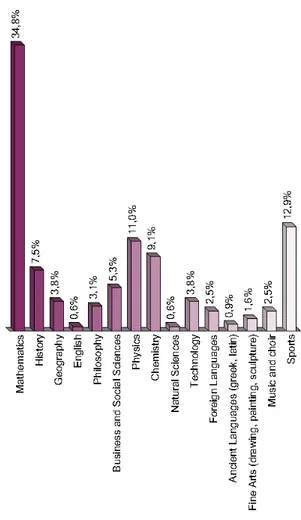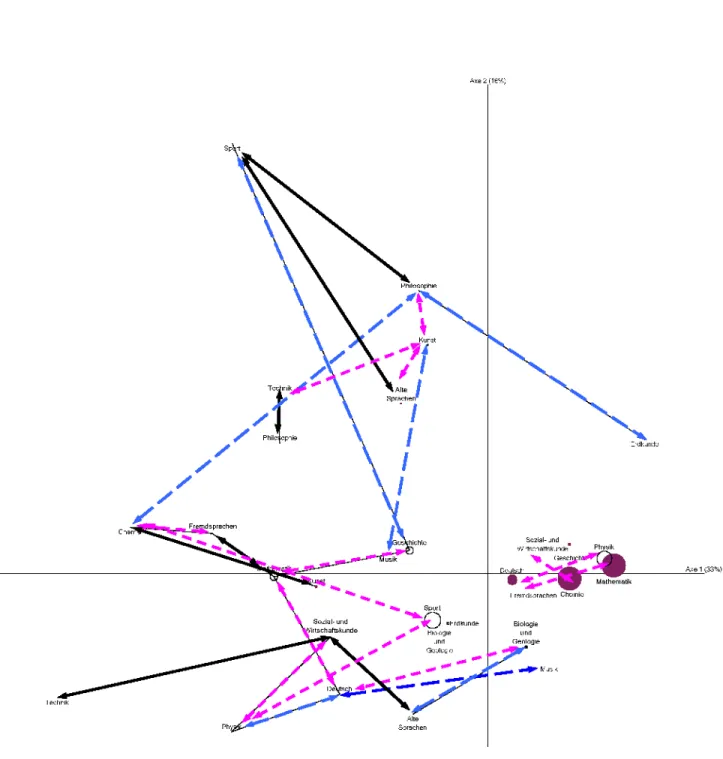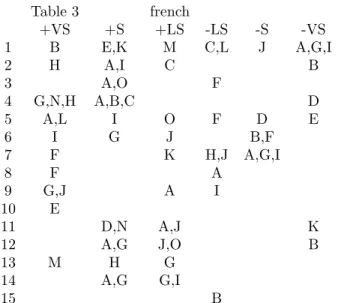HAL Id: hal-00753088
https://hal.archives-ouvertes.fr/hal-00753088
Submitted on 17 Nov 2012
HAL is a multi-disciplinary open access
archive for the deposit and dissemination of
sci-entific research documents, whether they are
pub-lished or not. The documents may come from
teaching and research institutions in France or
abroad, or from public or private research centers.
L’archive ouverte pluridisciplinaire HAL, est
destinée au dépôt et à la diffusion de documents
scientifiques de niveau recherche, publiés ou non,
émanant des établissements d’enseignement et de
recherche français ou étrangers, des laboratoires
publics ou privés.
INTERNATIONAL STUDY OF
MULTIDISCIPLINARY INTERACTIONS FOR
PROMOTING THE LEARNING OF MATHEMATICS
AND SCIENCE
René Lozi, Nicole Biagioli
To cite this version:
René Lozi, Nicole Biagioli. COMPLEX SYSTEMS IN EDUCATION: INTERNATIONAL STUDY
OF MULTIDISCIPLINARY INTERACTIONS FOR PROMOTING THE LEARNING OF
MATHE-MATICS AND SCIENCE. SOMC’2012 within ECCS’12, European Conference on Complex Systems,
Sep 2012, Brussels, Belgium. p. 17-28. �hal-00753088�
Proceedings of SOMC’2012 within ECCS’12 Self-Organization, Management and Control Brussels, Belgium - September 06 2012
COMPLEX SYSTEMS IN EDUCATION: INTERNATIONAL STUDY
OF MULTIDISCIPLINARY INTERACTIONS FOR PROMOTING
THE LEARNING OF MATHEMATICS AND SCIENCE
Ren´
e Lozi, Nicole Biagioli
∗†Abstract. A four languages international survey on school sys-tems is examined in the frame of complex networks. Unexpected differences are highlighted between countries when the cross rela-tionships between disliked and useful school subject are considered. Keywords. Mathematics learning, science learning, multidisci-plinary interactions, complex systems, international survey.
1
Introduction
The multidisciplinary study of complex systems in the physical and social sciences over the three past decades has led to the articulation of important new conceptual perspectives and methodologies that are of value to re-searchers in these fields.
The main goal of this article is to apply these new con-ceptual perspectives for promoting the learning of math-ematics and science which have to be improved in most of the european countries.
The results of the 2009 PISA survey (PISA is the acronym for the OECD programme for international stu-dent assesment) highlight that:
”Korea and Finland are the highest performing OECD countries, with mean scores of 539 and 536 points, respec-tively. However, the partner economy Shanghai-China outperforms them by a significant margin, with a mean score of 556. Top-performing countries or economies in reading literacy include Hong Kong-China (with a mean score of 533), Singapore (526), Canada (524), New Zealand (521), Japan (520) and Australia (515). The Netherlands (508), Belgium (506), Norway (503), Esto-nia (501), Switzerland (501), Poland (500), Iceland (500) and Liechtenstein (499) also perform above the OECD mean score of 494, while the United States, Sweden, Ger-many, Ireland, France, Denmark, the United Kingdom, Hungary, Portugal, and partner economy Chinese Taipei ∗Ren´e Lozi is with the Laboratory J. A. Dieudonn´e, CNRS
U.M.R. 7351 and the Laboratory I3DL, InterdiDactiques, Di-dactiques des Disciplines et des Langues E. A. 6308 E-mail: rlozi@unice.fr
†Nicole Biagioli is with the laboratory I3DL, InterdiDactiques,
Didactiques des Disciplines et des Langues E. A. 6308. E-mail: biagioli@unice.fr
have scores close to the OECD mean” [1].
Moreover: ”The results from the 2009 PISA assess-ment reveal wide differences in educational outcomes, both within and across countries. The education sys-tems that have been able to secure strong and equitable learning outcomes, and to mobilise rapid improvements, show others what is possible to achieve. Naturally, GDP per capita influences educational success, but this only explains 6% of the differences in average student per-formance. The other 94% reflect the potential for pub-lic popub-licy to make a difference. The stunning success of Shanghai-China, which tops every league table in this as-sessment by a clear margin, shows what can be achieved with moderate economic resources and in a diverse so-cial context. In mathematics, more than a quarter of Shanghai-China’s 15-year-olds can conceptualise, gener-alise, and creatively use information based on their own investigations and modelling of complex problem situa-tions. They can apply insight and understanding and develop new approaches and strategies when addressing novel situations. In the OECD area, just 3% of students reach that level of performance” [2].
One can conclude as said in PISA programme: ”While better educational outcomes are a strong predictor of eco-nomic growth, wealth and spending on education alone are no guarantee for better educational outcomes. Over-all, PISA shows that an image of a world divided neatly into rich and well-educated countries and poor and badly-educated countries is out of date” [2]. The main question which can arise then is: how to achieve a good level in mathematics and science in France and other european countries as done in China, Korea or Finland ?
With a team of researchers in various school subjects (we will call thereafter ”discipline” every school subject) we have conducted, between 2006 and 2012, an intertional survey, using Internet, on several aspects of na-tional school systems, under the pretext of asking read-ers of the famous worldwide saga ”Harry Potter”, on the characters created by J. K. Rowling [3]. Among a panel of 177 questions, some though hidden, were di-rectly connected to the scholar system of the countries related to one of the four languages in which the
sur-vey was conducted. We have obtained more than 9000 questionnaire replies (517 in english, 5250 in french, 1851 in german, 1608 in spanish). Of course the language of the survey is not uniquely related to one country, as for an example, people from 18 countries have replied in spanish: Argentina, Bolivia, Chile, Colombia, Costa Rica, Ecuador, Spain, Guatemala, Honduras, Mexico, Nicaragua, Panama, Paraguay, Peru, Dominican Repub-lic, El Salvador, Uruguay and Venezuela.
With the help of the replies on only few questions we show that the solution of the problem of achieving a good level in mathematics and science is not obvious and re-quires the analysis of complex relations. Such an analysis is similar to the analysis of complex systems. Further studies varying several parameters (sex, age, education level, taste for particular school subjects) are therefore needed in order to improve educational systems.
2
Raw results of the survey
Therafter we consider only three questions of our inter-national survey and the relationship between the replies.
These questions are:
- In your opinion, which subject taught in the actual world is the most useful (one single answer) ?
- In the actual world, what is the school subject you dislike (only one single answer) ?
- In the actual world, what is your favorite school sub-ject (only one single answer) ?
Of course these questions were not placed toghether in the questionnaires (their position were in 80th, 120th and 132nd places) as not to come to the attention of the Harry Potter’s fans. The possibles replies have to be cho-sen among the following ones: Mathematics, History, Ge-ography, Native language (of each survey), Philosophy, Business and social science, Physics, Chemistry, Natu-ral sciences, Technology, Foreign language, Ancient lan-guages (Greek, Latin), Fine Arts, Music and choir, Sport. Building the survey we were aware of gender study: concerning mathematics PISA 2009 shows that on aver-age across OECD countries, boys outperformed girls, with an advantage of 12 score points [2, p.137]. However gen-der differences in science performance tend to be small, both in absolute terms and when compared with the large gender gap in reading performance and the more moder-ate gender differences in mathematics. As our purpose is to promote the learning of mathematics and science, our priority is to consider first the replies of the female gen-der. Figures 1 to 4 display the results of the women above 15 years old in the english, french, german and spanish surveys for the question on the disliked discipline. The respective numbers of replies are: 319, 2959, 1065, 828. Uneventful, Mathematics is the most disliked discipline for the women of every country, ranking from 22,8 % (ger-man) to 34,8 % (english). Then Sport is the second one and Physics the third one (excepted for spanish women
who give History in the third position). In fourth posi-tion we find Business and social science (french survey), Chemistry (english and german), Physics (spanish).
Figure 1: Disliked school subjects for english women above 15 years old
These results are very similar whatever the country. However if we consider crossed results between disliked and most useful subject school in the actual world, we obtained surprising differences.
Complex Systems in Education
Figure 2: Disliked school subjects for french women above 15 years old
Figure 3: Disliked school subjects for german women above 15 years old
Figure 4: Disliked school subjects for spanish speaking women above 15 years old
3
Network analysis
We have considered simultaneously replies of both ques-tions:
- In your opinion, which subject taught in the actual world is the most useful ?
- In the actual world, what is the school subject you dislike ?
For these two questions we have done a principal com-ponent analysis (PCA) of the results (PCA is a math-ematical procedure that uses an orthogonal transforma-tion to convert a set of observatransforma-tions of possibly correlated variables into a set of values of linearly uncorrelated vari-ables called principal components. This transformation is defined in such a way that the first principal compo-nent has the largest possible variance (that is, accounts for as much of the variability in the data as possible), and each succeeding component in turn has the highest variance possible under the constraint that it be orthogo-nal to (i.e., uncorrelated with) the preceding components [4]), We display the results of the most significative corre-lations between disciplines in Figs. 5 (french), 6 (german) and 7 (english). The black arrows stand for very significa-tive correlation, the dashed blues arrows for significasignifica-tive correlation and the dotted pink arrrows for less significa-tive ones.
Fig. 8 displays useful school subjects in the actual world for freench women above 15 years old.
It is unexpected that the complexity of the networks are very differents between french survey (which is mainly related to the french’s school system), german survey (re-lated to german’s school) and english one (re(re-lated mainly to U.S.A.’s school system). The complexity of the french network for the cross analysis seems more important than the german network. The english network is the simplest one (the spanish network stands between the german and the english). In these network we have only displayed the positive correlations. Due to the complexity of the figure the analysis of both positive and negative correlation will be done using tables.
4
Other results
In this section, we consider the other replies and the cross relationship between them. Fig. 9 shows liked school subjects for women above 15 years old, while Fig. 10 displays disliked school subjects for men above 15 years old.
This figure is interesting when compared to Fig. 2 : na-tive language, Philosophy, foreign languages, ancient lan-guages, Fine Arts, Music and choir are more disliked by men than women. Instead, Mathematics, Physics, Tech-nology and sports are less liked. One can says that men are more ”scientific” than women. One can also compare useful school subjects between men and women (see Fig. 11 for french men and Fig. 8 for women) and also liked ones versus gender (see Fig. 12 for french men and Fig.
Complex Systems in Education
Complex Systems in Education
Figure 8: Useful school subjects for french women above
Complex Systems in Education
Figure 10: Disliked school subjects for french men above 15 years old
Figure 11: Useful school subjects for french men above 15 years old
Figure 12: Liked school subjects for french men above 15 years old
9 for women). Due to the limited extend of this article we do not display the corresponding comparison for the surveys in others languages.
Table 1
School subjects Useful Disliked
Mathematics A 1
History B 2
Geography C 3
Native language D 4
Philosophy E 5
Business social sci. F 6
Physics G 7 Chemistry H 8 Natural sciences I 9 Technology J 10 Foreign language K 11 Greek, Latin L 12 Fine Arts M 13
Music and choir N 14
Sport O 15
In order to extend the network analysis of previous sec-tion, we give some examples of correlation tables. School subjects are symbolized by letters for useful ones and by numbers for disliked (see Table 1).
Table 2 displays both positive and negative significative correlations between disciplines from the english survey.
+VS means positive very significant correlation, +S :positive significant correlation, +LS: positive less signif-icant
and -VS, -S, -LS have the same meaning for negative correlations. Table 2 english +VS +S +LS -LS -S -VS 1 A 2 3 L 4 I A 5 L H 6 I H 7 O 8 J 9 J 10 G 11 E F 12 13 N 14 F 15 A B
The first three columns are equivalent to the graph of Fig. 7, meanwhile the three last ones are not represented here by any graph.
Table 3 shows the more complex situation for the french survey when both positive and neagtive correlations are plotted.
Complex Systems in Education Table 3 french +VS +S +LS -LS -S -VS 1 B E,K M C,L J A,G,I 2 H A,I C B 3 A,O F 4 G,N,H A,B,C D 5 A,L I O F D E 6 I G J B,F 7 F K H,J A,G,I 8 F A 9 G,J A I 10 E 11 D,N A,J K 12 A,G J,O B 13 M H G 14 A,G G,I 15 B
The same comparison can be done for german (Table 4) and spanish survey (Table 5)
Table 4 german +VS +S +LS -LS -S -VS 1 K A 2 O A B 3 4 G,N A,I D 5 O C,H M D 6 J,L G 7 K A,G 8 F G 9 L 10 E M 11 A H K 12 O M 13 H 14 M A 15 G,H M Table 5 spanish +VS +S +LS -LS -S -VS 1 B D,F,K,O A 2 A J F D B 3 H,J 4 G A D,K 5 L E D 6 A,O G F K 7 D;E I 8 C F I 9 N I 10 11 C,E 12 13 I 14 A 15 G I
5
Conclusion
As said in the 2009 PISA survey:
”One of the ultimate goals of policy makers is to en-able citizens to take advantage of a globalised world econ-omy. This is leading them to focus on the improvement of education policies, ensuring the quality of service pro-vision, a more equitable distribution of learning oppor-tunities and stronger incentives for greater efficiency in schooling. Such policies hinge on reliable information on how well education systems prepare students for life. Most countries monitor students’ learning and the perfor-mance of schools. But in a global economy, the yardstick for success is no longer improvement by national stan-dards alone, but how education systems perform inter-nationally. The OECD has taken up that challenge by developing PISA, the Programme for International Stu-dent Assessment, which evaluates the quality, equity and efficiency of school systems in some 70 countries that, to-gether, make up ninetenths of the world economy. PISA represents a commitment by governments to monitor the outcomes of education systems regularly within an inter-nationally agreed framework and it provides a basis for international collaboration in defining and implementing educational policies”.[2]
We have tried to find a way in order to define a efficient educational policy especially for promoting the learning of mathematics and sciences. With the help of the replies on only few questions we show that the solution of such problem is not obvious and requires the analysis of com-plex relations. Such an analysis is similar to the analy-sis of complex systems. Discrepancies appear from one country to another. Further studies varying several pa-rameters (sex, age, education level, taste for particular school subjects) are therefore needed in order to improve educational systems. It seems that there remains a long way for that.
References
[1] PISA 2009 Results:Executive Summary,
http://www.oecd.org/dataoecd/34/60/46619703.pdf
[2] PISA 2009 What Students Know and Can Do: Stu-dent Performance in Reading, Mathematics and Sci-ence (Volume I), http://www.oecd.org/document/53/0,3746,
en 32252351 46584327 46584821 1 1 1 1,00.html.
[3] Rowling, J. K. (1997). Harry Potter and the Philosopher’s
Stone. Londres: Bloomsbury.
[4] Baccini, A. ”Statistique descriptive multidimensionnelle”,









